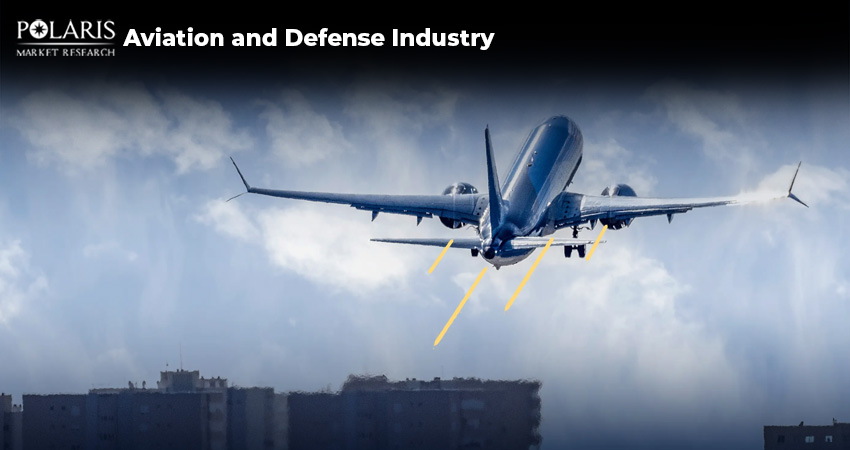How Aviation & Defense Sector is Evolving with Technology and Global Demands?

The skies have always held a certain attraction, a symbol of freedom, innovation, and strategic power. From the earliest biplanes to the advanced drones of today, the aviation & defense sector has consistently pushed the boundaries of human ingenuity. The industry has now evolved to be a cornerstone of global security, technological advancement, and economic growth.
With increasing geopolitical tensions, rising defense budgets, and the growing demand for sustainable aviation, companies in this space are investing heavily in R&D, AI, and green technologies. In this blog, we’ll explore the latest trends and key developments in the aviation & defense sector.
Aviation and Defense: Quick Overview
Aviation, derived from the Latin word "avis," meaning "bird," generally refers to the activity of flying aircraft, encompassing both the act of flying and the technologies and industries related to it. The ‘aviation industry’ encompasses all businesses and activities related to aircraft, including manufacturing, operation, and maintenance, as well as air transportation service. It includes various types of aircraft, such as fixed-wing planes, helicopters, drones, and even lighter-than-air vehicles like hot air balloons and airships. The aviation industry plays a crucial role in global connectivity, facilitating the movement of people and goods, supporting tourism, and enabling international trade.
The defense industry designs, manufactures, and supplies goods and services related to national security, military operations, and defense capabilities. It encompasses a wide range of activities, including the production of weapons, military vehicles, equipment, defense technology, and software systems. The global defense space is growing due to escalating conflicts, and geopolitical instability is driving nations to increase their defense spending and modernize their armed forces. Countries are investing in advanced technologies like AI, autonomous systems, and cyber warfare capabilities to enhance their military capabilities and deter potential adversaries. Additionally, in response to rising threats, many countries are increasing their defense budgets, leading to a surge in demand for defense equipment and services.
Key Trends Shaping Aviation
-
Digital Transformation: Aviation is undergoing a major digital shift, with airports and airlines investing in advanced technologies to streamline processes and enhance efficiency.
-
Hydrogen and Electric Aircraft: The anticipated entry of electric and hydrogen aircraft into the industry represents a transformative leap toward cleaner and more sustainable aviation.
-
Automation: Automation is revolutionizing baggage handling, with airports investing in automated systems and robotic assistance for tasks like sorting, transportation, and loading.
-
Sustainable Aviation Fuels (SAF) and Bio-Fuels: Manufacturers are focusing on sustainable fuels and technologies to reduce carbon emissions and achieve net-zero targets.
-
Artificial Intelligence (AI) and Machine Learning (ML): AI and ML are being used to improve various aspects of the aviation industry, from pilot training and aircraft maintenance to airport operations.
Major Trends Transforming Defense Landscape
-
AI-Enhanced Surveillance and Threat Detection: AI is being used to analyze vast amounts of data from various sources (satellites, drones, sensors) to improve real-time threat detection and decision-making.
-
Quantum-Resistant Cryptography: The emergence of quantum computing poses a threat to current encryption methods, leading to research and development of quantum-resistant cryptography to secure sensitive data.
-
Autonomous Systems: Robotics and autonomous systems are gaining traction for tasks like landmine clearance, explosive ordnance disposal, and search and rescue operations, reducing risks for soldiers and enhancing situational awareness.
-
Protecting the Digital Battlefield: With the increasing reliance on digital technologies, cybersecurity is paramount. This includes protecting communication networks, command and control systems, and critical infrastructure from cyberattacks.
-
Green Technologies: The defense industry is adopting sustainable practices to reduce its carbon footprint, including the development of biofuels, electrification of vehicles, and the use of lightweight materials.
Recent Developments in Aviation
Boeing and HPCL Collaboration
- In February 2025, Boeing and HPCL teamed up to promote India’s sustainable aviation fuel environment. As part of this partnership, Boeing and HPCL will look into ways to increase SAF production in India, assist in certifying domestically made SAF, and promote laws that will strengthen the nation's SAF ecosystem.
Airbus New Engine Introduction
- In March 2025, Airbus added the lightweight twin-engine H140 to its lineup. In terms of performance, economy, and the comfort of passengers and crew, the multi-mission helicopter sets the standard for light twin-engine aircraft.
Major Developments in Defense
Lockheed Martin’s New Counter-Unmanned Aerial Systems
- In February 2025, Lockheed Martin introduced options for scalable counter-unmanned aerial systems. An expanding array of effectors, inexpensive sensors, and Artificial Intelligence (AI)-enabled detection and tracking software are all combined with combat-tested command and control in this modular, open-architecture system.
New Engineering Facility of Collins Aerospace
- In March 2025, Collins Aerospace of RTX opened opened a new engineering and testing facility in Bengaluru, India, which will enhance India’s role in global aerospace development.
Growing Role of Cybersecurity in Aviation & Defense Systems
With digitalization transforming the aviation & defense sector, cybersecurity has become critical to protecting sensitive systems and data. In aviation, vulnerabilities in air traffic control, flight management, and passenger information systems are prime targets for cyberattacks. The digitalization of military assets, including weapons systems and communications, has increased the risk of cyber warfare in defense. Both industries are making significant investments in advanced technologies such as AI-driven threat detection, quantum-resistant encryption, and multi-factor authentication to safeguard their operations.
Final Thoughts
The aviation & defense sector is at the forefront of technological and strategic evolution. From AI-powered drones to hypersonic jets and space defense, the sector continues to redefine modern warfare and global transportation. As nations prioritize military modernization and sustainable aviation, leading players will play a pivotal role in shaping the future. This industry is a complex, crucial, and ever-evolving part of our world. Its continued development will shape the future of transportation, security, and exploration.

